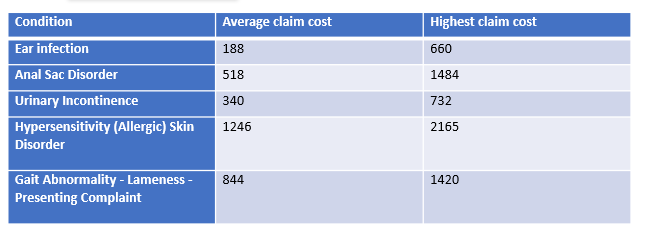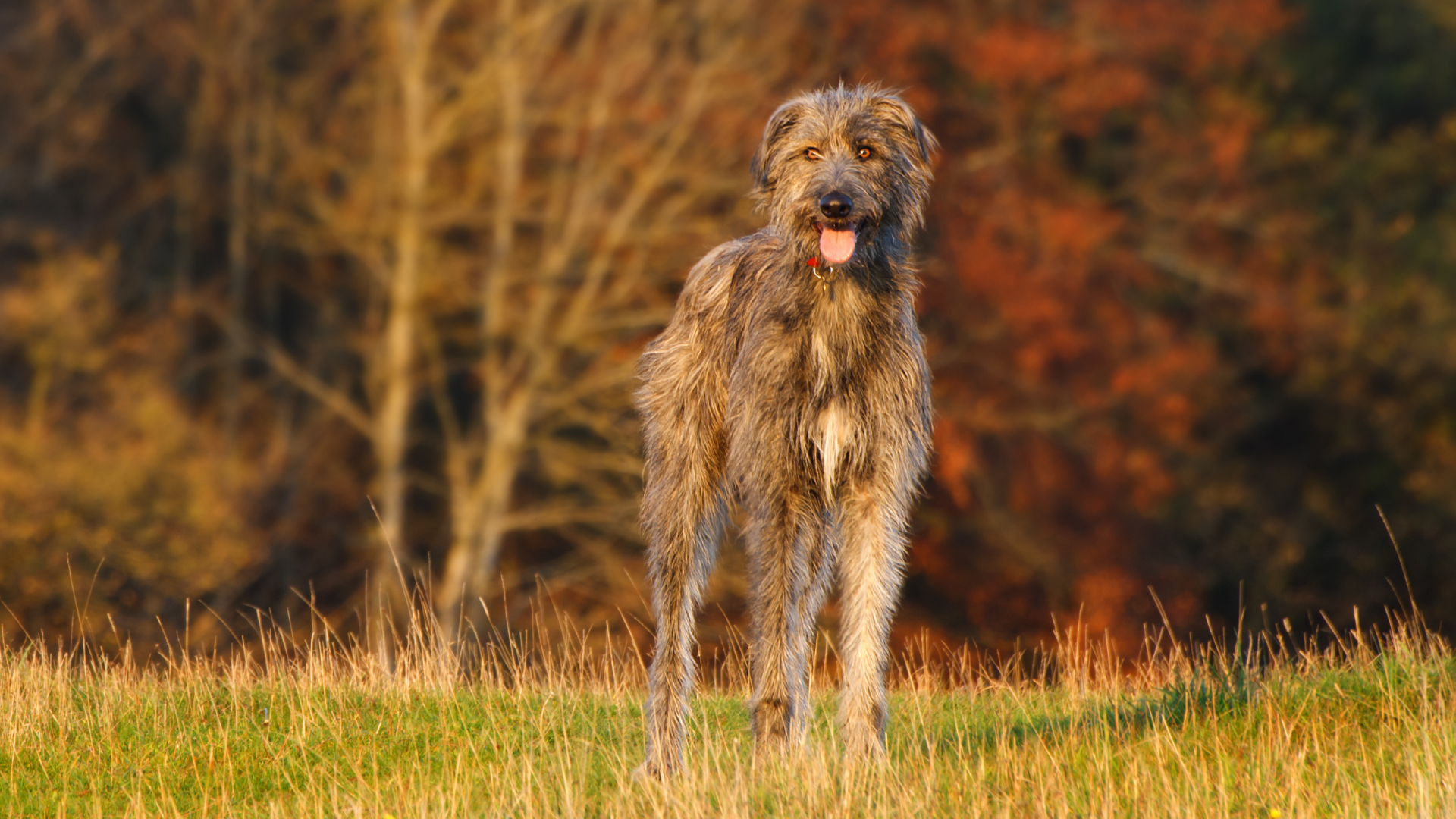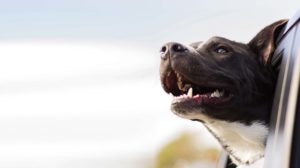Introduction and History
An ancient dog breed, possibly dating back to Ireland in 7000 BC, though the oldest written record of the Wolfhound is from Rome dating to 391 AD, when seven dogs were given to Quintus Aurelius as gifts. Irish Wolfhounds were treasured for their ability to hunt the wolves that preyed upon livestock, as well as giant Irish elk. For centuries, these dogs were reserved for nobility. The traditional practice of giving them as presents to foreign nobility, along with the extinction of the wolf in Ireland, contributed to the decline of the breed’s numbers in the 18th century. By the 19th century, they were almost extinct, and the Irish famine of 1845 further decimated the breed. However, in the 1860’s, restoration of the breed began with infusion of Scottish Deerhound, Great Dane, Borzoi , and Tibetan Wolfdog bloodlines to increase the gene pool. The first breed standard was adopted by the Irish Kennel Club in 1885.
Appearance and Personality
The tallest breed in the world, some males can reach 89 cm at the shoulder and weigh up to 81.6 kg. The average male stands up to 86 cm at the shoulder and weighs a minimum of 54.5 kg and females are a little smaller at around 76 cm at the shoulder and weigh between 40.5 and 48 kg. Irish Wolfhounds possess a hard, rough, wiry haircoat with a soft, dense undercoat that comes in brindle, grey, red, black, fawn, and white. It is a fairly low maintenance coat but will benefit from weekly or more frequently brushing with an undercoat rake and a pin brush. Their average lifespan is 6 to 8 years.
Adult dogs are generally calm, easy-going, and patient. Bred for running with great speed and stamina, they need daily exercise and space to frolic and are better suited to larger properties than apartment living. Although they are usually good with other animals and children, they do have a strong chase instinct and play should be supervised. Their strength and size may make them a better choice for families with older children as toddlers may get knocked or pulled over. Early training is important to help facilitate a great relationship between owner and Irish Wolfhound to avoid battles of strength. At home, Irish Wolfhounds need ample room to stretch out, with access to soft furniture and bedding to prevent calluses and pressure sores. As for all dogs, early socialisation to help them become used to other dogs, animals and people will help the Irish Wolfhound to grow into a well-adjusted adult dog.
Common Health Concerns
The five most common reasons for an Irish Wolfhound to visit the Vet (excluding routine care visits) according to PetSure data over the past five calendar years (2016-2020) included skin problems such as allergic skin disease, cancers including osteosarcoma, musculoskeletal problems like lameness and spinal pain, tumours, and gastrointestinal upsets.
The five most common reasons for an Irish Wolfhound to visit the Vet (excluding routine care visits); PetSure data (2020 calendar year):
| Rank | Condition | Average cost for single treatment (average pet insurance claim amount) | Highest cost for single treatment (highest pet insurance claim seen for this condition) |
| 1 | Skin problems including allergic skin disease, pododermatitis | $236 | $1,683 |
| 2 | Cancers, including osteosarcoma and lymphoma | $581 | $13,631 |
| 3 | Gastrointestinal problems, including Canine Haemorrhagic Gastroenteritis | $392 | $2,605 |
| 4 | Tumours, including hygromas | $381 | $1,991 |
| 5 | Ear infections | $154 | $606 |
Disclaimer: Reimbursement for these claims would be subject to limits, such as annual benefit limits or sub-limits, benefit percentage, applicable waiting periods and any applicable excess. Cover is subject to the policy terms and conditions. You should consider the relevant Product Disclosure Statement or policy wording available from the relevant provider.
For the same period (2020 calendar year), the top five highest single vet treatments (or highest pet insurance claims) for Irish Wolfhounds from PetSure data were:
| Rank | Condition | Highest Cost of treatment for condition (average pet insurance claim amount) |
| 1 | Neoplasia- osteosarcoma | $13,631 |
| 2 | Nailbed infection | $4,282 |
| 3 | Foreign body ingestion | $4,009 |
| 4 | Fibrocartilagenous embolism | $3,758 |
| 5 | Pressure sore | $3,446 |
Disclaimer: Reimbursement for these claims would be subject to limits, such as annual benefit limits or sub-limits, benefit percentage, applicable waiting periods and any applicable excess. Cover is subject to the policy terms and conditions. You should consider the relevant Product Disclosure Statement or policy wording available from the relevant provider.
Most popular Irish Wolfhound names from PetSure data from 2019-2020:
Most popular names
- Murphy
- Archie
- Clancy
- Finn
- Holly
- Peggy
- Sooty
- Alby
- Arnold
- Betty
Most popular female names
- Holly
- Peggy
- Betty
- Bindi
- Cassie
- Daisy
- Freya
- Kali
- Lacey
- Leah
Most popular male names:
- Murphy
- Archie
- Clancy
- Finn
- Sooty
- Alby
- Arnold
- Chico
- Jasper
- Merlin
Did you know?
Historically, Irish Wolfhounds were used in wars to drag men from their chariots and horses with their large size and agility allowing them to do this!
Frequently Asked Questions
Irish Wolfhound is an ancient dog breed, possibly dating back to Ireland in 7000 BC, though the oldest written record of the Wolfhound is from Rome dating back to 391 AD, when seven dogs were given to Quintus Aurelius as gifts. Irish Wolfhounds were treasured for their ability to hunt the wolves that preyed upon livestock, as well as giant Irish elk. For centuries, these dogs were reserved for nobility. The traditional practice of giving them as presents to foreign nobility, along with the extinction of the wolf in Ireland, contributed to the decline of the breed’s numbers in the 18th century. By the 19th century, they were almost extinct, and the Irish famine of 1845 further decimated the breed. However, in the 1860’s, restoration of the breed began with infusion of Scottish Deerhound, Great Dane, Borzoi and Tibetan Wolfdog bloodlines to increase the gene pool. The first breed standard was adopted by the Irish Kennel Club in 1885.
Irish Wolfhounds are a giant breed. On average, males typically stand around 81 to 86 cm tall at the shoulder, and females are usually slightly smaller, measuring 76 to 81 cm in height. They generally weigh between 54 to 70 kg.
Adult dogs are generally calm, easy going and patient. Bred for running with great speed and stamina, they need daily exercise and space to frolic and are better suited to larger properties than apartment living.
Yes, Irish Wolfhounds are generally good with children. They are known to be patient and tolerant, making them suitable companions for kids. Although they are usually good with other animals and children, they do have a strong chase instinct and play should be supervised. Their strength and size may make them a better choice for families with older children as toddlers may get knocked or pulled over. Early training is important to help facilitate a great relationship between owner and Irish Wolfhound to avoid battles of strength.
Irish Wolfhounds are a large and active breed. They need regular exercise to stay healthy and mentally stimulated. Daily walks and opportunities for off-leash running in a safe and secure area are beneficial for their well-being.
Irish Wolfhounds are intelligent dogs, but they can also be independent and stubborn at times. They respond best to positive reinforcement training methods and gentle guidance. Early socialisation and consistent, patient training are important for their development.
Irish Wolfhounds can get along well with other pets, including dogs and cats if properly socialised from a young age. However, due to their size and strength, caution is advised when introducing them to smaller animals. Supervision and controlled introductions are necessary.
The average lifespan of an Irish Wolfhound is typically around 6 to 8 years.
Irish Wolfhounds have a medium-length, wiry coat that requires regular grooming to keep it in good condition. Regular brushing and occasional hand-stripping or trimming are necessary. Their coat sheds moderately, so regular maintenance helps keep it healthy and reduces loose hair.

Disclaimer: Reimbursement for these claims would be subject to limits, such as annual benefit limits or sub-limits, benefit percentage, applicable waiting periods and any applicable excess. Cover is subject to the policy terms and conditions. You should consider the relevant Product Disclosure Statement or policy wording available from the relevant provider.
* Please note that the values calculated are based on all claims for that condition and medically related conditions in each calendar year.
References
- American Kennel Club, Irish Wolfhound
- Australian National Kennel Council 2021, Breed Standard of the Irish Wolfhound
- Irish Central, History and fun facts about Irish Wolfhounds
- Wikipedia, Irish wolfhound
Pet insurance can help by covering a portion of the eligible vet bill if the unexpected happens. Because it is difficult to predict the costs of veterinary care, it can help to have measures in place to help prepare for the unexpected. Check out our partner network and explore our policy tools to find a pet insurance policy.
Not all conditions or items are covered by Pet Insurance. Refer to the applicable Product Disclosure Statement for information about coverage and exclusions.



 Fact checked
Fact checked





